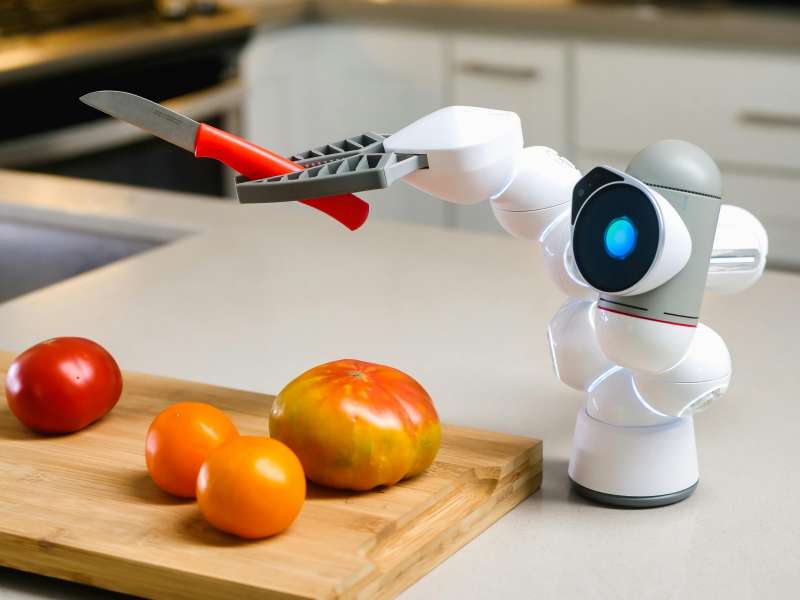Humanoid Robots: New Opportunities for Automation
Published on: May 1, 2025
Humanoid Robots: Expanding the Frontiers of Automation
Humanoid robots, defined by their human-like appearance and ability to mimic human movements, are rapidly emerging as a transformative force in the field of automation. Unlike traditional industrial robots that are typically designed for repetitive tasks within controlled environments, humanoid robots are engineered to operate in dynamic, human-centric settings. Their ability to interact naturally with people and navigate spaces designed for humans opens up a wide array of new possibilities in sectors such as logistics, service industries, public spaces, education, and research. With advancements in artificial intelligence, sensor technology, and robotics engineering, humanoid robots are not only enhancing efficiency but also redefining the boundaries of what machines can achieve in collaboration with humans.
The Evolution of Humanoid Robots
The concept of humanoid robots has fascinated scientists and engineers for decades. Early prototypes, such as WABOT-1 developed in Japan in the 1970s, could perform basic tasks like walking and grasping objects. Over the years, significant progress in computational power, artificial intelligence, and materials science has enabled the creation of more sophisticated humanoid robots. Today’s humanoids, such as Honda’s ASIMO, SoftBank’s Pepper, Boston Dynamics’ Atlas, and Tesla’s Optimus, feature advanced sensors, articulated limbs, and complex control systems that enable them to walk, run, manipulate objects, and even interpret human emotions.
Modern humanoid robots are equipped with a range of sensors, including cameras, microphones, LiDAR, and tactile sensors, allowing them to perceive and understand their environment. Machine learning algorithms process this sensory data to recognize objects, understand speech, and respond appropriately to human cues. This integration of hardware and software has been instrumental in making humanoid robots suitable for tasks that require dexterity, adaptability, and human-like interaction.
Humanoid Robots in Logistics and Warehousing
The logistics and warehousing sector is witnessing a paradigm shift with the introduction of humanoid robots. Traditionally, automation in warehouses has relied on fixed robotic arms and autonomous mobile robots (AMRs) for sorting, picking, and transporting goods. However, many logistics tasks still require human-like manipulation, flexibility, and decision-making—areas where humanoid robots excel.
Humanoid robots can navigate complex warehouse environments, recognize and handle a wide variety of objects, and perform tasks such as picking items from shelves, packing boxes, and loading goods onto delivery vehicles. Their human-like form allows them to use existing infrastructure, such as ladders, door handles, and elevators, without the need for costly modifications. For example, Sanctuary AI’s Phoenix robot is designed to perform hundreds of tasks that previously required human labor, including working with tools and interacting with touchscreens.
In addition to physical tasks, humanoid robots can be integrated with warehouse management systems to optimize workflows, track inventory, and ensure real-time communication with human staff. By automating repetitive and physically demanding tasks, humanoid robots improve operational efficiency, reduce workplace injuries, and help address labor shortages in the logistics industry.
Service Industry Applications: Hospitality, Retail, and Beyond
The service industry is another domain where humanoid robots are making significant inroads. Their ability to interact with customers in a natural and engaging manner makes them ideal for roles in hospitality, retail, and customer service. In hotels, humanoid robots like SoftBank’s Pepper and Savioke’s Relay are being deployed to greet guests, provide information, deliver amenities, and guide visitors to their rooms.
In retail environments, humanoid robots can assist shoppers by answering questions, locating products, and providing personalized recommendations. Their presence not only enhances the customer experience but also frees up human staff to focus on more complex or sensitive tasks. Humanoid robots equipped with payment processing capabilities can even facilitate transactions, making the shopping process more efficient and enjoyable.
Restaurants and cafes are also experimenting with humanoid robots for taking orders, serving food, and clearing tables. In 2022, the Japanese company Dawn Avatar Robot Café introduced humanoid robots operated remotely by people with disabilities, demonstrating how robotics can create inclusive job opportunities and improve accessibility in the service sector.
Public Spaces: Airports, Hospitals, and Shopping Centers
Humanoid robots are increasingly being deployed in public spaces, where their ability to interact naturally with people and adapt to unpredictable environments is particularly valuable. In airports, robots such as LG’s CLOi GuideBot and Hitachi’s EMIEW3 help travelers navigate terminals, provide flight information, and assist with language translation. Their presence helps streamline passenger flow and reduce congestion, especially during peak travel times.
Hospitals and healthcare facilities are leveraging humanoid robots to support both patients and staff. Robots like PAL Robotics’ REEM and Pepper have been used to greet visitors, guide them to the correct departments, and provide information about hospital services. In some cases, humanoid robots assist with routine tasks such as delivering medications, transporting medical supplies, and disinfecting rooms. During the COVID-19 pandemic, robots played a crucial role in reducing human contact, thus minimizing the risk of infection for healthcare workers and patients alike.
In shopping centers and malls, humanoid robots serve as information kiosks, security assistants, and entertainment providers. Their ability to engage with visitors, answer questions, and even perform simple demonstrations or dances adds a unique and interactive dimension to the shopping experience. As these robots become more advanced, they are expected to take on additional responsibilities, such as crowd management and emergency response.
Human-Robot Interaction: The Key to Social Acceptance
One of the defining features of humanoid robots is their capacity for natural human-robot interaction (HRI). Research in this area focuses on making robots more intuitive, empathetic, and responsive to human needs. This involves not only sophisticated speech recognition and natural language processing but also the ability to interpret non-verbal cues such as facial expressions, gestures, and body language.
Social robots like Pepper and Nao have been used in various studies to explore how people respond to robots in different contexts. Findings suggest that a robot’s appearance, behavior, and communication style significantly influence user acceptance and trust. For instance, robots that can display emotions, maintain eye contact, and use polite language are more likely to be perceived as friendly and approachable.
Designers and engineers are working to ensure that humanoid robots can adapt their interactions based on the age, culture, and preferences of the people they encounter. This personalization is critical for applications in education, healthcare, and customer service, where building rapport and trust is essential for success.
Humanoid Robots in Education
Education is a sector where humanoid robots are opening up new possibilities for teaching and learning. Robots such as NAO, Pepper, and Robothespian are being used as teaching assistants, language tutors, and interactive learning companions. Their ability to engage students through conversation, gestures, and multimedia presentations makes them valuable tools for personalized and inclusive education.
In classrooms, humanoid robots can help deliver lessons, answer questions, and provide real-time feedback to students. They are particularly effective in supporting children with special educational needs, such as autism spectrum disorders, by offering consistent and patient interactions. Research conducted in Japan, the United States, and Europe has shown that students often respond positively to robot instructors, viewing them as non-judgmental and supportive learning partners.
Beyond primary and secondary education, humanoid robots are being used in universities and research institutions as platforms for experimentation and innovation. Robotics students can program and customize humanoid robots to explore topics such as artificial intelligence, machine learning, and human-robot interaction. These hands-on experiences prepare the next generation of engineers and scientists to push the boundaries of robotics technology.
Research and Development: Pushing the Limits of Robotics
Humanoid robots play a crucial role in advancing research across multiple disciplines. In robotics and artificial intelligence, they serve as testbeds for developing new algorithms, control systems, and adaptive behaviors. For example, Boston Dynamics’ Atlas robot is widely used in research projects focused on dynamic locomotion, balance, and manipulation in unstructured environments.
In cognitive science and psychology, humanoid robots provide a unique platform for studying human behavior, social cognition, and the mechanisms underlying learning and adaptation. Experiments involving robots and humans interacting in controlled settings have yielded valuable insights into how people perceive machines and how robots can be designed to elicit positive responses.
Humanoid robots are also driving innovation in fields such as biomechanics, materials science, and sensor technology. Engineers are developing lightweight, flexible actuators and artificial muscles that mimic human movement, as well as advanced sensors that provide robots with a sense of touch and proprioception. These technological breakthroughs not only enhance the capabilities of humanoid robots but also have applications in prosthetics, exoskeletons, and assistive devices for people with disabilities.
Challenges and Ethical Considerations
Despite their many advantages, the widespread adoption of humanoid robots raises important technical, ethical, and societal challenges. One major technical hurdle is achieving robust and reliable performance in real-world environments, where unexpected obstacles and human unpredictability can pose significant difficulties. Ensuring the safety of both robots and humans is paramount, particularly in crowded public spaces or when robots are tasked with handling hazardous materials.
Ethical considerations include questions about privacy, autonomy, and the potential displacement of human workers. As humanoid robots become more capable of collecting and processing personal data, it is essential to establish clear guidelines for data protection and user consent. Additionally, the integration of robots into the workforce must be managed carefully to ensure that automation complements rather than replaces human labor, particularly in sectors where social interaction and empathy are critical.
Public perception and acceptance of humanoid robots are also influenced by cultural factors, media representation, and individual experiences. Addressing fears and misconceptions about robots—such as concerns about job loss, loss of control, or dehumanization—requires transparent communication, inclusive design, and ongoing dialogue between developers, users, and policymakers.
The Future of Humanoid Robots in Automation
The trajectory of humanoid robot development points toward even greater integration into daily life and work. As artificial intelligence continues to advance, robots will become more autonomous, adaptive, and capable of learning from experience. The emergence of collaborative robots, or cobots, highlights the potential for humans and robots to work side by side, leveraging each other’s strengths to achieve shared goals.
In the coming years, we can expect humanoid robots to take on increasingly complex roles in healthcare, eldercare, disaster response, and space exploration. For example, NASA’s Robonaut and Russia’s FEDOR have already demonstrated the utility of humanoid robots in performing tasks aboard the International Space Station. In disaster scenarios, robots can navigate dangerous environments, locate survivors, and deliver supplies, reducing risks for human responders.
As the cost of robotics technology decreases and accessibility increases, small and medium-sized enterprises will also benefit from the automation potential of humanoid robots. This democratization of robotics will foster innovation, create new business models, and expand the range of services that can be automated.
Ultimately, the successful integration of humanoid robots into society depends on continued research, responsible development, and a commitment to ensuring that technology serves the needs and values of people. By embracing the opportunities and addressing the challenges, humanoid robots have the potential to transform automation and enrich human life in ways that were once the realm of science fiction.










